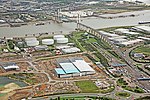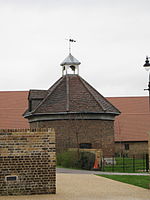The Dartford-Thurrock River Crossing, commonly known as the Dartford Crossing and until 1991 the Dartford Tunnel, is a major road crossing of the River Thames in England, carrying the A282 road between Dartford in Kent in the south and Thurrock in Essex in the north.
It consists of two bored tunnels and the cable-stayed Queen Elizabeth II Bridge. The only fixed road crossing of the Thames east of Greater London, it is the busiest estuarial crossing in the United Kingdom, with an average daily use of over 130,000 vehicles. It opened in stages: the west tunnel in 1963, the east tunnel in 1980 and the bridge in 1991. The crossing, although not officially designated a motorway, is considered part of the M25 motorway's route, using the tunnels northbound and bridge southbound. Described as one of the most important road crossings in Britain, it suffers from heavy traffic and congestion.
The crossing's development started in the late 1930s, but was interrupted due to the Second World War and resumed in the 1950s. The original tunnel catered for a single lane of traffic in each direction, but rising traffic levels required the second tunnel to be built. The M25 connected to the tunnels at both ends when completed in 1986, and the increased traffic put pressure on the tunnels' capacity. A private finance initiative scheme was started in 1988 to build the bridge. The combined crossing now handles four lanes of traffic in each direction.
The crossing has always been tolled, and though the cost of construction has since been paid back, the toll was retained, and rebranded as a congestion pricing scheme from 1 April 2003. Since 2008 it has been free from 10 pm to 6 am. An automatic number plate recognition charging scheme named the "Dart Charge" began in November 2014. As a result, the booths on the Kent side were removed and the charge is now only payable online, by post, or in certain participating retail outlets. A residents' scheme is available, offering discounts for people living near the crossing.






